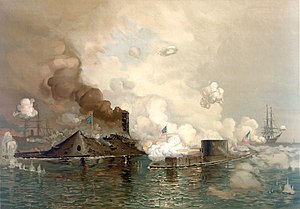Battle of Hampton Roads
| Battle of Hampton Roads (Battle of Ironclads) |
|||||||
|---|---|---|---|---|---|---|---|
 Chromolithograph depicting the Battle of Hampton Roads. |
|||||||
|
|||||||
| Belligerents | |||||||
|
|
|
||||||
| Commanders and leaders | |||||||
|
Louis M. Goldsborough (not present) John Marston (senior officer present) |
Franklin Buchanan Catesby ap Roger Jones |
||||||
| Strength | |||||||
| 1 ironclad 5 wooden frigates |
1 ironclad 2 wooden warships 1 gunboat 2 tenders |
||||||
| Casualties and losses | |||||||
| 261 killed 108 wounded 1 frigate sunk 1 sloop-of-war sunk 1 frigate damaged |
78 killed 17 wounded 1 ironclad damaged |
||||||
Indecisive stalemate
The Battle of Hampton Roads, often referred to as either the Battle of the Monitor and Merrimack (or Virginia) or the Battle of Ironclads, was the most noted and arguably most important naval battle of the American Civil War from the standpoint of the development of navies. It was fought over two days, March 8–9, 1862, in Hampton Roads, a roadstead in Virginia where the Elizabeth and Nansemond rivers meet the James River just before it enters Chesapeake Bay adjacent to the city of Norfolk. The battle was a part of the effort of the Confederacy to break the Union blockade, which had cut off Virginia's largest cities, Norfolk and Richmond, from international trade.
The major significance of the battle is that it was the first meeting in combat of ironclad warships, i.e., the USS Monitor and the CSS Virginia. The Confederate fleet consisted of the ironclad ram Virginia (built from the remnants of the USS Merrimack) and several supporting vessels. On the first day of battle, they were opposed by several conventional, wooden-hulled ships of the Union Navy. On that day, Virginia was able to destroy two ships of the Federal flotilla, USS Congress and USS Cumberland, and was about to attack a third, USS Minnesota, which had run aground. However, the action was halted by darkness and falling tide, so Virginia retired to take care of her few wounded—which included her captain, Flag Officer Franklin Buchanan—and repair her minimal battle damage.
...
Wikipedia
